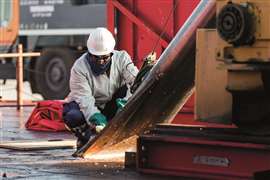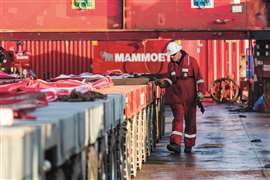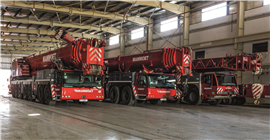How to decide whether to keep or replace a crane
21 February 2024
As equipment ages, how do you decide whether to keep it running or get shot of it? John Helmink, European manager at Mammoet’s equipment management department, explained some thoughts to Alex Dahm.
 John Helmink, European manager at Mammoet’s equipment management department. (Photo: Mammoet)
John Helmink, European manager at Mammoet’s equipment management department. (Photo: Mammoet)
Decisions about buying and operating capital equipment can make or break a business in a short time.
Many factors are taken into account when determining whether to keep or replace a machine. In addition to fundamentals like reliability and safety, careful consideration may be given to, for example, the balance between sustainability and the need for or benefits of the latest technology and functionality, whole life cost and so on. As an example, is it less damaging to the environment to continue repairing an existing crane instead of replacing it, possibly even for decades?
Repairing and refurbishing can also be cheaper but at what point does the improved lifting performance, reduced environmental impact or other advantages of a new model over an old one shift the balance in favour of replacement?
ICST got some thoughts and answers on these and other questions from John Helmink, Europe manager of the equipment management department at Mammoet, which runs by far the world’s largest fleet of cranes and specialized transport equipment. The Netherlands-headquartered company is also at the forefront in its sector of environmental awareness.
Alex Dahm: How do you measure and then weigh up the pros and cons of repairing and refurbishing a crane over replacing it with a new (or used) one?
John Helmink: This happens based on a few factors. Due to the fact that each and every piece of equipment is unique, this is never a straightforward exercise. In general we can say that the amount of time the equipment has been in our fleet is an important factor in having it replaced or not.
We want each crane to be kept in the optimum condition until we divest it, regardless of whether we’re planning to do that soon or later on. For example, we have the situation going on right now where we have a crane, which is not ready for operations. We do want to sell it this summer. Yet we give it the repairs needed and we execute maintenance to make sure that we can rely on it like any other crane and when the moment comes then we sell a well-maintained machine to its next owner.
 Mammoet says gathering real world data about equipment is vital in the keep or replace decision-making process. (Photo: Mammoet)
Mammoet says gathering real world data about equipment is vital in the keep or replace decision-making process. (Photo: Mammoet)
AD: How much does the sustainability element play a part in the decision to repair or replace?
JH: In general, if you maintain your equipment well, you’ve got efficiently operating machines. From an emissions perspective, you do want to run efficiently.
Also, we plan in advance when cranes get their maintenance. Most of the time they are maintained at a workshop close to their home base. Wherever possible, we will not move cranes long distances to be maintained.
It is important that equipment is maintained in a specialist facility. For example, if you have an oil spillage, you need to be prepared to deal with this correctly – so you’ve got the right tools, the right setup for proper maintenance.
AD: How much does lifting performance play a part in the decision to repair or replace a crane?
JH: From day to day, the operator of any piece of equipment is acutely aware of how it is performing, and they certainly let us know if there is any degradation. We can also rely on the equipment specifications we receive from manufacturers.
If for some reason the crane does not perform like it should, then we take action. Next to this, we’re constantly performing routine maintenance, for example checking for degradation of oil.
So in that sense, we kind of monitor from a technical perspective whether there’s an indication that the machine is not operating as it should.
AD: How much does new safety technology play a part in the decision to repair or replace a crane?
JH: Safety is something we never compromise on at Mammoet. Safety measures are not usually a significant enough investment to factor into replacement decision-making, however. Although new models of cranes do in general have better safety measures implemented, cranes we already operate in our fleet can also be equipped with new safety features. For example, we are currently working on having an older crawler crane equipped with a fall prevention system. Also, we installed a 360 degree view camera system and pedestrian alert system on an existing mobile crane.
 Mammoet says it plans in advance when cranes get their maintenance. (Photo: Mammoet)
Mammoet says it plans in advance when cranes get their maintenance. (Photo: Mammoet)
So, in this sense, we are not dependent on new cranes for still having new safety measures installed on our cranes. We also have many workshops capable of manufacturing custom improvements for equipment, should the need arise.
AD: How much does anything else play a part in the decision to repair or replace a crane?
JH: Safe operations and reliability for our customers are key factors that affect our repair and refurbishment strategy. Mammoet is known for having a relatively young fleet, and we maintain this to keep reliability high. This helps to secure delivery of our services to our customers. In parallel we make sure that we invest in preventive maintenance of our existing fleet as both are needed for reliable and safe operations.
Reliability plays an even more important role for some of the equipment which is mobilised to very distant locations. For our customers and also for our colleagues out in the field it is important that it can be relied upon to perform.
AD: How much a part of the equation is the condition or repair or replacement cost of the power unit in deciding whether to refurbish a crane or not? How and how much would it sway your repair or replace decision?
JH: Equipment doesn’t break down often. Also, the heavy lifting phase of projects comes at very specific moments in time. So, before we are involved, there is time to set up and test equipment to perform at the highest level.
Between lifts or transports, you need to wait, so again there’s time to test your machine and take preventive measures.
More generally, we’re talking about equipment that is pretty unlikely to reach its end of life any time soon, and that has been well maintained by our network of expert mechanics. Also, when resold we would like to maintain our reputation for providing quality used equipment to the market.
 Look after your tools and they will look after you, says Mammoet. (Photo: Mammoet)
Look after your tools and they will look after you, says Mammoet. (Photo: Mammoet)
AD: Do you have a calculation or assessment criteria model for deciding to repair or replace, especially in light of availability of replacement, cost, environmental cost, etc, or is it all done on a case-by-case basis?
JH: Predominantly on a case-by-case basis, but with the above network of checks and balances in place, where operators are on constant alert, equipment is brought in for predictive maintenance in line with manufacturer standards, and the age of the fleet is kept low.
The location a piece of equipment works at is also a factor. You might want to use an older machine on sites that you know will be dirty and a newer machine where everything is kept really clean.
AD: How much information does Mammoet as a customer get from crane manufacturers about whole life cost of a crane or trailer or other piece of equipment?
JH: I feel that real world data is most important, regarding this. Real life operations can put equipment in environments that are not exactly unexpected but can cause unusual usage profiles.
We have been talking about cranes really but to provide another example, there’s a lot more to it. We also have the SPMT [self propelled modular transporter) for example. We have SPMT coming in from jobs next to the North Sea, being near salt water all the time, maybe not having that many hours of operation but still needing maintenance due to the corrosion that has taken place.
STAY CONNECTED


Receive the information you need when you need it through our world-leading magazines, newsletters and daily briefings.




